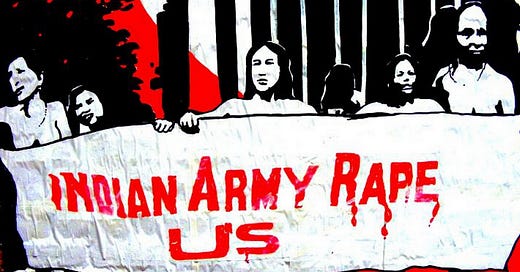What is it about the ‘naked protest’ of 2004 that continues to resonate to this day? Why does it hold such a significant place in the crowded annals of contemporary Indian history and politics?
The Mothers of Manipur: Twelve Women Who Made History by Teresa Rehman raises these and many more important questions. It attempts to answer them through stories of the twelve Imas (mothers of Manipur), who were a part of the historic protest.
In this process, this work of non-fiction and journalistic inquiry charts what it means to write a new language of protest, employing some of the existing structures of thought in society but overturning them at every point.
Helens and Draupadis: Bodies as Sites Of Struggle
The body has always been a site of struggle. One simply has to turn the pages of history and/or myth — both of which dominate the organisation of society’s structures of thought — to know how bodies are used by those in power to own, control, and subjugate.
Women’s bodies are especially significant in this discourse as it is in these bodies that ideas of honour (maan), shame (sharm), purity (pavitrata, also in the sense of virginity), and boundary (the maryada of the home but also the borders of the nation-state — remember India’s depiction as Bharat Mata?) intersect.
The Helens and Draupadis of the world stand as examples of the violence that ensues when these intersecting threads are threatened by forces that may cause them to break.
“Indian Army Rape Us, Take Our Flesh”: The Body In Protest
However, what happens when the same bodies become sites of protest? The dominant social narrative is turned upon its head!
This is exactly what happened when the mothers of Manipur made the brave decision of protesting naked at the Kangla Fort in Imphal, Manipur in 2004. The women were protesting against the Armed Forces (Special Powers) Act (AFSPA) that Manipur has been under since 1980 and the brutal rape and murder of Thangjam Manorama.
In Rehman’s book, one mother, Ima Momon recalls her nervousness while standing in front of the Kangla gate.
“Would she really be able to do it? . . . After she had stripped fully, instead of feeling a sense of shame, she felt stronger. Shaking the iron gates and screaming ‘Come and rape us’ made her feel powerful.”
The shame narrative is, therefore, overturned. It is an act of owning back one’s body; an act of regaining agency. As another mother, Ima Ramani puts it,
“By stripping, we wanted to deliver a message — you can see whatever you want and for as long as you want.”
In “Written on the Body”, Trina Nileena Banerjee writes (as quoted in The Mothers of Manipur),
“A naked woman’s body had refused to titillate, to evoke lust or desire, to assume forms that were publicly considered immoral — but were implicitly more acceptable than this powerful, horrifying, completely autonomous nakedness.”
“Like Raping Oneself”: The Psychological Cost
Discussions on bodies often constitute — especially in today’s day and age when movements like #MeToo and #TimesUp have gained momentum — topics such as bad touch, consent, and dignity. The bottom line is that one should not harm another’s body, physically or mentally.
When bodies become sites of protest — when harming the self is the only way to make your voice heard — the effect it has on the human psyche is unimaginable. There is a huge psychological cost to be paid.
“The women had decided that on principle, stripping was almost as good as dying.”
One mother, Ima Mema — who spends sleepless nights troubled by thoughts of her community — says in the book,
“It was almost like raping oneself.”
Acts like these not only affect the self but also one’s family and loved ones. The mothers kept the decision to hold the protest a secret from their families and most were worried about the way their loved ones would react. Fortunately for most (though not all), the families were extremely supportive.
“Injured Is an Inner State of Being”: A Story to Be Told
Rehman’s book lays bare the fact that “injured is an inner state of being in Manipur”; it puts Manipur — often viewed in the popular imagination as “a hazy geo-political riddle in a remote corner” — on the physical and mental map of India.
It is a story to be told; a people’s history that counters the state’s selective and systemic storytelling and its cultures of silence. The Imas are never silent; stories and legends are continually passed on from one generation to another through a sustaining oral narrative tradition.
“It’s almost as if Ima Ramani enters a time warp and begins to tell us about some lesser known slices of Manipur’s history. Men, women and children, all part of her family, come out and watch and listen as she starts speaking.”
The ‘naked protest’, Pamela Philipose tells us in the Introduction to Rehman’s book, has become the subject of numerous creative enactments and reenactments. Mahasweta Devi’s Draupadi, for instance, took a new meaning after the protest.
Like these creative reworkings, Rahman’s book is an attempt to keep the memory of the protest and the marginalised voices of people alive, for the story of Manipur, as Ima Jibanmala says, “is too long to end in one conversation”.
Also read:





